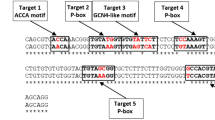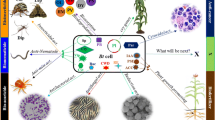Abstract
Artemisinin derivatives are effective anti-malarial drugs. In order to design transgenic plants of Artemisia annua with enhanced biosynthesis of artemisinin, we are studying the promoters of genes encoding enzymes involved in artemisinin biosynthesis. A 1,151 bp promoter region of the cyp71av1 gene, encoding amorpha-4,11-diene 12-hydroxylase, was cloned. Alignment of the cloned promoter and other cyp71av1 promoter sequences indicated that the cyp71av1 promoter may be different in different A. annua varieties. Comparison to the promoter of amorpha-4,11-diene synthase gene showed a number of putative cis-acting regulatory elements in common, suggesting a co-regulation of the two genes. The cyp71av1 promoter sequence was fused to the β-glucuronidase (GUS) reporter gene and two varieties of A. annua and Nicotiana tabacum were transformed. In A. annua, GUS expression was exclusively localized to glandular secretory trichomes (GSTs) of leaf primordia and top expanded leaves. In older leaves, there is a shift of expression to T-shaped trichomes (TSTs). Only TSTs showed GUS staining in lower leaves and there is no GUS staining in old leaves. GUS expression in flower buds was specifically localized to GSTs. The recombinant promoter carries the cis-acting regulatory elements required for GST-specific expression. The cyp71av1 promoter shows activity in young tissues. The recombinant promoter was up to 200 times more active than the wild type promoter. GUS expression in transgenic N. tabacum was localized to glandular heads. Transcript levels were up-regulated by MeJA. Wound responsiveness experiment showed that the cyp71av1 promoter does not appear to play any role in the response of A. annua to mechanical stress.












Similar content being viewed by others
References
Aftab T, Khan MMA, Idrees M, Naeem M, Singh M, Ram M (2010) Stimulation of crop productivity, photosynthesis and artemisinin production in Artemisia annua L. by triacontanol and gibberellic acid application. J Plant Interact 5:273–281. doi:10.1080/17429141003647137
Angelova Z, Georgiev S, Roos W (2006) Elicitation of plants. Biotechnol Biotechnol Eq 20:72–83
Baldi A, Dixit VK (2008) Yield enhancement strategies for artemisinin production by suspension cultures of Artemisia annua. Biores Technol 99:4609–4614. doi:10.1016/j.biortech.2007.06.061
Banyai W, Mii M, Supaibulwatana K (2011) Enhancement of artemisinin content and biomass in Artemisia annua by exogenous GA3 treatment. Plant Growth Regul 63:45–54. doi:10.1007/s10725-010-9510-9
Boter M, Ruiz-Rivero O, Abdeen A, Prat S (2004) Conserved MYC transcription factors play a key role in jasmonate signaling both in tomato and Arabidopsis. Genes Dev 18:1577–1591. doi:10.1101/gad.297704
Bouwmeester HJ, Wallaart TE, Janssen MH, van Loo B, Jansen BJ, Posthumus MA, Schmidt CO, de Kraker JW, Konig WA, Franssen MC (1999) Amorpha-4, 11-diene synthase catalyses the first probable step in artemisinin biosynthesis. Phytochemistry 52:843–854. doi:10.1016/S0031-9422(99)00206-X
Brown GD, Sy LK (2004) In vivo transformations of dihydroartemisinic acid in Artemisia annua plants. Tetrahedron 60:1139–1159. doi:10.1016/j.tet.2003.11.070
Brown GD, Sy LK (2007) In vivo transformations of artemisinic acid in Artemisia annua plants. Tetrahedron 63:9548–9566. doi:10.1016/j.tet.2007.06.062
Caretto S, Quarta A, Durante M, Nisi R, De Paolis A, Blando F, Mita G (2011) Methyl jasmonate and miconazole differently affect arteminisin production and gene expression in Artemisia annua suspension cultures. Plant Biol 13:51–58. doi:10.1111/j.1438-8677.2009.00306.x
Chen JL, Fang HM, Ji YP, Pu GB, Guo YW, Huang LL, Du ZG, Liu BY, Ye HC, Li GF, Wang H (2011) Artemisinin biosynthesis enhancement in transgenic Artemisia annua plants by downregulation of the β-caryophyllene synthase gene. Plant Med 77:1759–1765. doi:10.1055/s-0030-1271038
Covello PS, Teoh KH, Polichuk DR (2007) Function genomic and biosynthesis of artemisinin. Phytochemistry 68:1864–1871. doi:10.1016/j.phytochem.2007.02.016
Deyholos MK, Sieburth LE (2000) Separable whorl-specific expression and negative regulation by enhancer elements within the AGAMOUS second intron. Plant Cell 12:1799–1810. doi:10.1105/tpc.12.10.1799
Duke MV, Paul RN, Elsohly HN, Sturtz G, Duke SO (1994) Localization of artemisinin and artemisitene in foliar tissues of glanded and glandless biotypes of Artemisia annua L. Int J Plant Sci 155:365–372. doi:10.1086/297173
Fütterer J, Gisel A, Iglesias V, Klöti A, Kost B, Mittelsten Scheid O, Neuhaus G, Neuhaus-Url G, Schrott M, Shillito R, Spangenberg G, Wang ZY (1995) Standard molecular techniques for the analysis of transgenic plants”. In: Potrykus I, Spangenberg G (eds) Gene transfer to plants. Springer, Berlin, pp 215–263
Guom X-X, Yang X-Q, Yang R-Y, Zeng Q-P (2010) Salicylic acid and methyl jasmonate but not Rose Bengal enhance artemisinin production through invoking burst of endogenous singlet oxygen. Plant Sci 178:390–397. doi:10.1016/j.plantsci.2010.01.014
Han JL, Liu BY, Ye HC, Wang H, Li Z-Q, Li G-F (2006) Effects of overexpression of the endogenous farnesyl diphosphate synthase on the artemisinin content in Artemisia annua L. J Integrat Plant Biol 48:482–487. doi:10.1111/j.1744-7909.2006.00208.x
Hobo T, Asada M, Kowyama Y, Hattori T (1999) ACGT-containing abscisic acid response element (ABRE) and coupling element 3 (CE3) are functionally equivalent. Plant J 19:679–689. doi:10.1046/j.1365-313x.1999.00565.x
Jefferson RA, Kavanagh TA, Bevan MW (1987) GUS fusions: beta-glucuronidase as a sensitive and versatile gene fusion marker in higher plants. EMBO J 6:3901–3907
Jing F, Zhang L, Li M, Tang Y, Wang Y, Wang Y, Wang Q, Pan Q, Wang G, Tang K (2009) Abscisic acid (ABA) treatment increases artemisinin content in Artemisia annua by enhancing the expression of genes in artemisinin biosynthetic pathway. Biologia 64:319–323. doi:10.2478/s11756-009-0040-8
Kim J, Kim H-Y (2006) Molecular characterization of a bHLH transcription factor involved in Arabidopsis abscisic acid-mediated response. Biochim Biophys Acta 1759:191–194. doi:10.1016/j.bbaexp.2006.03.002
Lei C, Ma D, Pu G, Qiu X, Du Z, Wang H, Li G, Ye H, Liu B (2011) Foliar application of chitosan activates artemisinin biosynthesis in Artemisia annua L. Ind Crop Prod 33:176–182. doi:10.1016/j.indcrop.2010.10.001
Li LF, Rui YY, Xue QY, Xiao MZ, Wen JL, Qing PZ (2009) Synergistic re-channeling of mevalonate pathway for enhanced artemisinin production in transgenic Artemisia annua. Plant Sci 177:57–67. doi:10.1016/j.plantsci.2009.03.014
Liu DH, Zhang LD, Li CX, Yang K, Wang YY, Sun XF, Tang K (2010) Effect of wounding on gene expression involved in artemisinin biosynthesis and artemisinin production in Artemisia annua. Russ J Plant Physiol 57:882–886. doi:10.1134/S102144371006018X
Livak KJ, Schmittgen TD (2001) Analysis of relative gene expression data using real-time quantitative PCR and the 2-∆∆Ct method. Methods 25:402–408. doi:10.1006/meth.2001.1262
Lommen WJM, Schenk E, Bouwmeester HJ, Verstappen FWA (2006) Trichome dynamics and artemisinin accumulation during development and senescence of Artemisia annua leaves. Planta Med 72:336–345. doi:10.1055/s-2005-916202
Lommen WJM, Elzinga S, Verstappen FWA, Bouwmeester HJ (2007) Artemisinin and sesquiterpene precursors in dead and green leaves of Artemisia annua L. crops. Planta Med 73:1133–1139. doi:10.1055/s-2007-981567
Lommen WJM, Bouwmeester HJ, Schenk E, Verstappen FWA, Elzinga S, Struik PC (2008) Modelling processes determining and limiting the production of secondary metabolites during crop growth: the example of the antimalarial artemisinin produced in Artemisia annua. Acta Hort 765:87–94
Ma D, Pu G, Lei C, Ma L, Wang H, Guo Y, Chen J, Du Z, Wang H, Li G, Ye H, Liu B (2009) Isolation and characterization of AaWRKY1, an Artemisia annua transcription factor that regulates the amorpha-4,11-diene synthase gene, a key gene of artemisinin biosynthesis. Plant Cell Phys 50:2146–2161. doi:10.1093/pcp/pcp149
Maes L, van Nieuwerburgh FCW, Zhang Y, Reed DW, Pollier J, Vande Casteele SRF, Inze D, Covello PS, Deforce DLD, Goossens A (2011) Dissection of the phytohormonal regulation of trichome formation and biosynthesis of the antimalarial compound artemisinin in Artemisia annua plants. New Phytol 189:176–189. doi:10.1111/j.1469-8137.2010.03466.x
Mascarenhas D, Mettler IJ, Pierce DA, Lowe HW (1990) Intron-mediated enhancement of heterologous gene expression in maize. Plant Mol Biol 15:913–920. doi:10.1007/BF00039430
Mercke P, Bengtsson M, Bouwmeester HJ, Posthumus MA, Brodelius PE (2000) Molecular cloning, expression, and characterization of amorpha-4,11-diene synthase, a key enzyme of artemisinin biosynthesis in Artemisia annua L. Arch Biochem Biophys 381:173–180. doi:10.1006/abbi.2000.1962
Miller JN, Miller JC (2010) Statistics and chemometrics for analytical chemistry, 6th edn. Prentice Hall, UK
Miyamoto K, Shimizu T, Lin F, Sainsbury F, Thuenemann E, Lomonossoff G, Nojiri H, Yamane H, Okada K (2012) Identification of an E-box motif responsible for the expression of jasmonic acid-induced chitinase gene OsChia4a in rice. J Plant Physiol 169:621–627
Nafis T, Akmal M, Ram M, Alam P, Ahlawat S, Mohd A, Abdin MZ (2011) Enhancement of artemisinin content by constitutive expression of the HMG-CoA reductase gene in high-yielding strain of Artemisia annua L. Plant Biotechnol Rep 5:53–60. doi:10.1007/s11816-010-0156-x
Narusaka Y, Nakashima K, Shinwari ZK, Sakuma Y, Furihata T, Abe H, Narusaka M, Shinozaki K, Yamaguchi-Shinozaki K (2003) Interaction between two cis-acting elements, ABRE and DRE, in ABA-dependent expression of Arabidopsis rd29A gene in response to dehydration and high-salinity stresses. Plant J 34:137–148. doi:10.1046/j.1365-313X.2003.01708.x
Olofsson L, Lundgren A, Brodelius PE (2012) Trichome isolation with and without fixation using laser microdissection and pressure catapulting followed by RNA amplification: expression of genes of terpene metabolism in apical and sub-apical trichome cells of Artemisia annua L. Plant Sci 183:9–13. doi:10.1016/j.plantsci.2011.10.019
Olsson ME, Olofsson LM, Lindahl A-L, Lundgren A, Brodelius M, Brodelius PE (2009) Localization of enzymes of artemisinin biosynthesis to the apical cells of glandular secretory trichomes of Artemisia annua L. Phytochemistry 70:1123–1128. doi:10.1016/j.phytochem.2009.07.009
Polichuk D, Teoh K, Zhang Y, Ellens KW, Reed DW, Covello PS (2010) Nucleotide sequence encoding an alcohol dehydrogenase from Artemisia annua and uses therof. Patent Application WO/2010/012074
Pu GB, Ma DM, Chen JL, Ma LQ, Wang H, Li GF, Ye HC, Liu BY (2009) Salicylic acid activates artemisinin biosynthesis in Artemisia annua L. Plant Cell Rep 28:1127–1135. doi:10.1007/s00299-009-0713-3
Putalun W, Luealon W, De-Eknamkul W, Tanaka H, Shoyama Y (2007) Improvement of artemisinin production by chitosan in hairy root cultures of Artemisia annua L. Biotechnol Lett 29:1143–1146. doi:10.1007/s10529-007-9368-8
Rathore D, McCutchan TF, Sullivan M, Kumar S (2005) Antimalarial drugs: current status and new developments. Expert Opin Investig Drugs 14:871–883
Rushton PJ, Somssich IE, Ringler P, Shen QJ (2010) WRKY transcription factors. Trends Plant Sci 15:247–258. doi:10.1016/j.tplants.2010.02.006
Sawant SV, Singh PK, Gupta SK, Madnala R, Tuli R (1999) Conserved nucleotide sequences in highly expressed genes in plants. J Genet 78:123–131
Shen Q, Ho TH (1995) Functional dissection of an abscisic acid (ABA)-inducible gene reveals two independent ABA-responsive complexes each containing a G-box and a novel cis-acting element. Plant Cell 7:295–307. doi:10.1105/tpc.7.3.295
Shen Q, Zhang P, Ho TH (1996) Modular nature of abscisic acid (ABA) response complexes: composite promoter units that are necessary and sufficient for ABA induction of gene expression in barley. Plant Cell 8:1107–1119. doi:10.1105/tpc.8.7.1107
Teoh KH, Polichuk DR, Reed DW, Nowak G, Covello PS (2006) Artemisia annua L. (Asteraceae) trichome-specific cDNAs reveal CYP71AV1, a cytochrome P450 with a key role in the biosynthesis of the antimalarial sesquiterpene lactone artemisinin. FEBS Lett 580:1411–1416. doi:10.1016/j.febslet.2006.01.065
Teoh KH, Polichuk DR, Reed DW, Covello PS (2009) Molecular cloning of an aldehyde dehydrogenase implicated in artemisinin biosynthesis in Artemisia annua. Botany 87:635–642. doi:10.1139/B09-032
Wang Y, Yang K, Jing F, Li M, Deng T, Huang R, Wang B, Wang G, Sun X, Tang KX (2011a) Cloning and characterization of trichome specific promoter of CYP71AV1 gene involved in artemisinin biosynthesis in Artemisia annua L. Mol Biol 45:751–758. doi:10.1134/S0026893311040145
Wang H, Olofsson L, Lundgren A, Brodelius PE (2011b) Trichome-specific expression of amorpha-4,11-diene synthase, a key enzyme of artemisinin biosynthesis in Artemisia annua, as reported by a promoter-GUS fusion. Am J Plant Sci 2:619–628. doi:10.4236/ajps.2011.24073
Wu W, Yuan M, Zhang Q, Zhu Y, Yong L, Wang W, Oi Y, Guo D (2011) Chemotype-dependent metabolic response to methyl jasmonate elicitation in Artemisia annua. Planta Med 77:1048–1053. doi:10.1055/s-0030-1250744
Yu ZX, Li JX, Yang CQ, Hu WL, Wang LJ, Chen XY (2012) The jasmonate-responsive AP2/ERF transcription factors AaERF1 and AaERF2 positively regulate artemisinin biosynthesis in Artemisia annua L. Mol Plant 5:353–365
Zhang YS, Ye HC, Liu BY, Wangand H, Li GF (2005) Exogenous GA3 and flowering induce the conversion of artemisinic acid to artemisinin in Artemisia annua plants. Russ J Plant Physiol 52:58–62. doi:10.1007/s11183-005-0009-6
Zhang Y, Teoh KH, Reed DW, Maes L, Goossens A, Olson DJ, Ross AR, Covello PS (2008) The molecular cloning of artemisinic aldehyde Δ11(13) reductase and its role in glandular trichome-dependent biosynthesis of artemisinin in Artemisia annua. J Biol Chem 283:21501–21508. doi:10.1074/jbc.M803090200
Author information
Authors and Affiliations
Corresponding author
Rights and permissions
About this article
Cite this article
Wang, H., Han, J., Kanagarajan, S. et al. Trichome-specific expression of the amorpha-4,11-diene 12-hydroxylase (cyp71av1) gene, encoding a key enzyme of artemisinin biosynthesis in Artemisia annua, as reported by a promoter-GUS fusion. Plant Mol Biol 81, 119–138 (2013). https://doi.org/10.1007/s11103-012-9986-y
Received:
Accepted:
Published:
Issue Date:
DOI: https://doi.org/10.1007/s11103-012-9986-y




